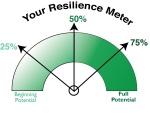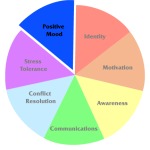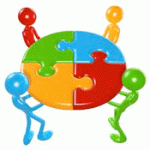
Joy, Anger, Disgust, Fear and Sadness interact in Inside Out, a 2015 American computer-animated comedy-drama film produced by Pixar Animation Studios and Walt Disney Pictures. The film is set in the mind of an 11 year old girl, Riley, who has been very happy until her parents uproot her as they move from Minnesota to San Francisco. She becomes unhappy in her new world without friends and her emotions go through considerable turbulence before they get it together and help her tell her parents of her troubles. Riley’s parents comfort her and a year later she has friends and a new capacity to hold emotional complexity. Go see the movie; it’s good for all ages!
There’s much more to the story, which does an excellent job of showing how emotions activate our responses, work with memories and can lead us to derail or succeed. Emotions always influence our behavior and our decisions. The question is how to engage with our emotions so we are successful and the movie helps us learn more about how this process works.
One key component in Inside Out is the interplay between the emotions of joy and sadness. Joy has run Riley’s emotions much of her life until the move, and then Sadness begins to have impacts. Joy seeks to prevent Sadness having an influence, but after a fairly difficult adventure they learn of the importance of these two emotions working together. While Joy and Sadness are gone on their learning journey, Fear, Anger and Disgust start guiding Riley’s behavior, which leads to starting to run away and other consequences.
Adults can learn a great deal from this reflection on emotional interaction. We can stop and reflect asking ourselves:
- “What emotions run my show? What are the consequences?
- “Would I like to make any changes?”
- “What one change would I like to inquire about first?”
Personal Inquiry is an opportunity to stop and listen, to reflect, recognize and perhaps reorganize our thoughts or our behavior. It is a key part of being mindful. Mindfulness has many powerful descriptions created by those who coach or teach personal development or personal evolution. It is core to many spiritual practices and is central to many strategies for expanding emotional and social intelligence. Webster defines mindfulness as “the practice of maintaining a nonjudgmental state of heightened or complete awareness of one’s thoughts, emotions, or experiences on a moment-to-moment basis.” It’s paying attention to our thoughts, feelings, bodily sensations and the physical environment without judgment. Mindfulness can be a powerful and restful state.
Stopping, breathing and being mindful provides an opportunity to gain perspective, to allow complexity of emotions to develop as they integrate, and then to peacefully choose your next response instead of being at the effect of a situation. This strategy taps into all 16 EI skills; some of the most prominent are emotional self-awareness, reality testing, impulse control, optimism and happiness.
One excellent article, published by Greater Good in Action, on Inside Out, emphasizes four lessons from children from the movie. Joy worked hard to suppress Sadness in the movie and that can be dangerous the author’s point out. Joy drew a circle away from the action board and asked Sadness to just stand in it so she wouldn’t impact Riley. Emotions can be tough, but they need to be experienced in age appropriate ways. Suppressing sadness can lead to anxiety and depression. Trying to reinterpret an event so it isn’t as difficult, sometimes called cognitive reappraisal or reframing, can cause the message of the difficult emotion to be camouflaged but not eliminated – and this can be costly later on as it could lead to emotional explosion or to self-medicating to keep the emotions away.
One of the best ways of managing impulse control can be to find safe ways to know how we feel and to process responses to those feelings. Then those difficult emotions are not lying in wait to jump out when we’re crossed in just the wrong way. Mindfulness, together with personal inquiry, helps us slow down and recognize the complexity of our feelings and then respond thoughtfully. It helps us manage our Resilience Meter™ as we’ve discussed in other articles. Mindfulness practice holds many gifts including the integration of our emotions at a level that allows us to live the purpose inspired life we prefer.









